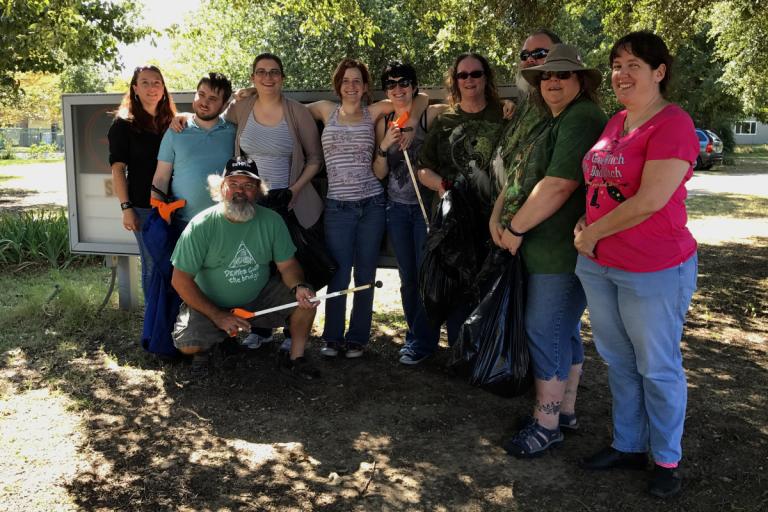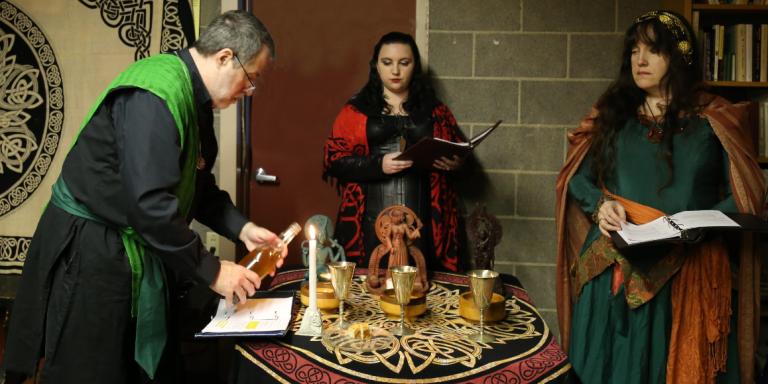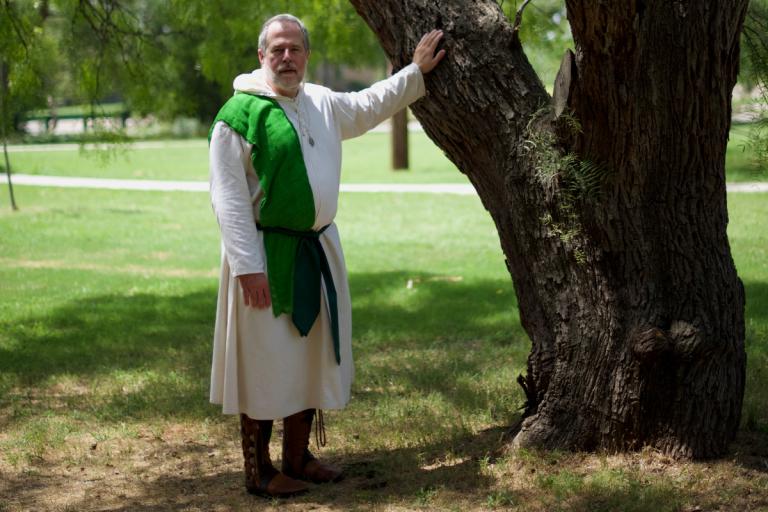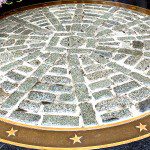A couple weeks ago ADF Druid and Texas Imbolc Retreat lead organizer Chris Godwin got some interesting responses with a Facebook post that asked “How do you like your Druids? Kilted or robed?” The conversation quickly moved beyond those two options to a general discussion of how Pagan clergy should dress.
I started a response, then decided I needed to write about setting your own agenda and a commitment to truth instead. But part of my agenda is writing about the ins and outs of being a Pagan priest, so I want to pick this up again and discuss some of the issues that were raised in the Facebook conversation.
In one of the few written reports we have of the ancient Druids, the Roman Pliny the Elder wrote that the Druids wore white robes. The Revival Druids of the 18th and 19th centuries jumped on that, and white robes have been considered traditional for Druids ever since. In 2012 I wrote a post on Druids and Their Robes that explained some of the choices contemporary Druids made and why they made them.

There are some traditions that have specific rules about how clergy should dress or must dress. If you’re part of one of those traditions, your decision is already made and this post isn’t for you. For the rest of us, though, if you consider yourself clergy or if you function as clergy there are a few things you should keep in mind.
Others will judge you, your tradition, and all of Paganism by your appearance. Since I was a small child I’ve heard people say “don’t judge me by my appearance, judge me by my results.” Occasionally I’ve said that myself. Our mainstream culture has made some progress (I haven’t worn a tie in 15 years), but it’s been more a shift in styles than a broadening of acceptance.
We all judge people on their appearance. Even those of us who go to great lengths to treat everyone with the same dignity and courtesy still make assumptions based on how people are dressed. Occasionally those assumptions are wrong (sometimes embarrassingly so) but most times they’re at least partially right – that why we continue to make them.
If you wear jeans and t-shirts, people will make certain assumptions. If you dress like you just came from a RenFaire, they’ll make other assumptions. If you wear khakis and a polo shirt, they’ll make still different assumptions. If you want ordinary people to treat you like they’d treat a Protestant clergyperson, you’re going to have to dress like a Protestant clergyperson.
Make your clothing choices consciously. Understand who’s going to see you and how you want to them to respond, then dress accordingly.
Dress for the occasion. If you’re leading a large ritual, you may want to wear your finest robes and jewelry. If you’re doing business with the city, you’re going to want to fit in at city hall. And if you’re doing a service project planting trees or picking up trash, you’ll need jeans, boots, and gloves.

What you wear should help you do a better job with your priestly work, not interfere with it. The robe (or the kilt, or the jewelry) does not make the Pagan.
If I’m teaching, counseling, or doing business with the public, I’m generally wearing business casual – in part because that’s what’s generally expected in those environments, and in part because that’s what’s in my closet for my paying job.
Always bring dignity to your work. If you are clergy or if you function as clergy (i.e. – leading rituals, counseling others, and generally representing your tradition) you have an obligation to create a favorable impression. This is particularly important for us as Pagans, since most people’s sample size is very small. They’ve seen enough Protestant ministers that they may say “gee, that Baptist preacher sure dresses like a slob” but they’ll make broader assumptions about us: “Pagans are slobs.”
Remember that what you wear often isn’t nearly as important as how you wear it. Being neat and clean goes a long way in making a good impression.
Of course, being neat and clean when everyone else has their hands dirty picking up trash makes a different, not so favorable impression. Dress for the occasion.

Ritual has an element of theatre. Ordinary work done for religious purposes is one thing. Leading ritual is another. Ritual dress should help set the atmosphere. It should say “this is a serious event” (unless, of course, it isn’t a serious event). If you’re doing a reconstructionist ritual, put a bit of work into figuring out how your ancient ancestors might have dressed for the occasion. If you can’t do a full costume, bring in jewelry or other accessories. It doesn’t have to be perfect, it just has to look like it fits the culture.
Whether you’re a High Priestess, a sworn priest of the Deity of the Occasion, or just the person leading the ritual this time, if you’re functioning as a priest, dress like a priest! Look like this is important to you, like you gave some thought to how you present yourself. If you do this often, invest in a good robe. If you don’t like robes, or if they don’t fit your tradition, get a special dress or shirt or coat that looks good and that you reserve for ritual use. Find something that sends the message “this isn’t an ordinary occasion” “this is special” “this is sacred.”
When you are serving as a priest, you are serving as a representative of the Gods. You owe it to Them to make a good impression with your appearance as much as with your words and your actions. All three help facilitate an experience for the other participants.

But ritual is more than theatre. Good ritual doesn’t just create feelings. Good ritual facilitates an experience of Gods and spirits. It works magic. It isn’t just a show – it’s work… and work requires suitable work clothes.
Long, flowy sleeves can catch on fire or knock over chalices. Northern European costumes are murder in the Texas summer. And if you’re going to be on your feet all night, “being in touch with the Earth” is going to have to take a back seat to providing some support, particularly for those of us who aren’t exactly young any more. I’ve started wearing Dr. Martens for rituals. They were designed for factory workers – they do quite nicely keeping a Druid upright until cleanup is finished.
I rarely wear robes in private or solitary ritual. I wear nice, normal clothes – even by myself, if I look like a slob I’ll feel like a slob and I won’t do a good job in the ritual. But I usually wear some of my Pagan jewelry. Putting it on is special and reminds me that I’m about to do something special.
Serving as Pagan clergy is an honor, a privilege, and a responsibility. We who fill these roles have an obligation to our Gods and to our traditions to present ourselves to the public and to our co-religionists as serious, competent, and thoughtful. This require study and practice, but it also requires paying attention to how we dress.

















